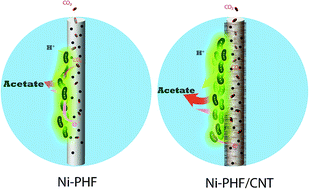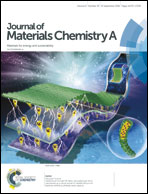Porous nickel hollow fiber cathodes coated with CNTs for efficient microbial electrosynthesis of acetate from CO2 using Sporomusa ovata†
Abstract
Microbial electrosynthesis (MES) allows recycling of CO2 into value added products by coupling renewable energy to the microbial ability for complex product formation. To improve biofilm formation on the cathode and the rates of product generation, the design of cathodes possessing a high specific surface area and enhanced electrode–microbe electron transfer is needed. This study aimed to demonstrate a novel cathode design that is made of porous nickel hollow fibers (Ni-PHFs), for facilitating direct delivery of CO2 to Sporomusa ovata in MES through the pores in the hollow fibers. Modification of the surface of Ni-PHFs with carbon nanotubes (CNTs) resulted in an 11-fold increase in the CO2 adsorption capability at atmospheric pressure, as well as 76.3% reduction of cathode electron transfer resistance. This cathode surface modification partially explained the higher acetate production rate of 247 ± 17 mM d−1 m−2 from direct CO2 delivery through the pores of the Ni-PHF/CNT cathode, compared to 145 ± 4 mM d−1 m2 for the Ni-PHF cathode. Higher electron recovery in the form of acetate (∼83%) was also observed for the Ni-PHF/CNT cathode. As for the tests where CO2 was sparged into the medium, acetate production was 36% lower than tests with direct CO2 delivery to S. ovata through the pores of the Ni-PHF/CNT cathode. These results demonstrate that using the PHF electrode design and modifying the cathode morphology to enhance the microbe–electrode interactions and CO2 availability for bacterial growth are effective approaches to increase the rates of CO2 reduction in MES.



 Please wait while we load your content...
Please wait while we load your content...